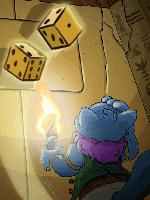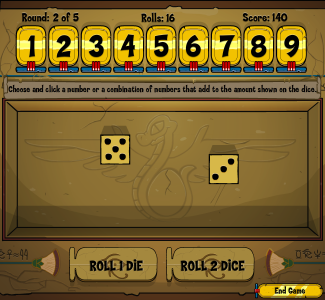Difference between revisions of "Dice of Destiny"
Crimsonfox (talk | contribs) m (→Trivia: GameCatNav template) |
(wikified introduction, gmc, how to play, screenshot, probability table, external link) |
||
| Line 2: | Line 2: | ||
|GameImage=Ctp 1126.gif | |GameImage=Ctp 1126.gif | ||
|GameID=1126 | |GameID=1126 | ||
|World= | |World=Lost Desert | ||
|Categories= | |Categories=Luck & Chance | ||
}} | }} | ||
'''Dice of Destiny''' is | '''Dice of Destiny''' is game of chance released on 9 July 2009. The player must help a [[Wocky]] exploring a tomb to beat a puzzle in a limited number of dice rolls. The player must clear all nine levers in each round by rolling the dice and pushing a combination of levers that add up to the number they rolled. | ||
It was the first game to be featured in the [[New Game Challenge]], and was also featured in the [[Games Master Challenge]] in [[Games Master Challenge 2010|2010]]. | |||
==How to play== | |||
[[Image:Dice of destiny screenshot.png|thumb|left|325px|Having rolled an eight, the player can choose to clear the eight; the seven and one; the six and two; the five and three; or the five, two, and one.]] | |||
Every round, the player must make the numbers one to nine by rolling one or two dice. Once they have rolled the dice, they can use any combination of the levers numbered one to nine to make the number they rolled. For example, if the player rolls an eight, they can choose to either use the number eight; the numbers seven and one; the numbers six and two; the numbers five and three; or the numbers five, two, and one. Each number can only be used once per round. Ten points are earned every time a numbered lever is used. | |||
The player can either choose to roll two dice or one die at a time, however, they only have so many rolls per round. In the first round, the player must make all the numbers in twenty rolls; in the second round they have seventeen rolls; in the third round they have fifteen rolls; in the fourth round they have twelve rolls, and in the fifth and final round they have ten rolls. | |||
The probability of rolling each number is shown in the following table. | |||
{| class="wikitable sortable" style="text-align: center; width: 400px; margin: 0 auto;" | |||
!rowspan="2"|Number | |||
!colspan="2"|Probability | |||
|- | |||
!One die | |||
!Two dice | |||
|- | |||
|1 | |||
|0.1<span style="text-decoration:overline">6</span> | |||
|0 | |||
|- | |||
|2 | |||
|0.1<span style="text-decoration:overline">6</span> | |||
|0.02<span style="text-decoration:overline">7</span> | |||
|- | |||
|3 | |||
|0.1<span style="text-decoration:overline">6</span> | |||
|0.0<span style="text-decoration:overline">5</span> | |||
|- | |||
|4 | |||
|0.1<span style="text-decoration:overline">6</span> | |||
|0.08<span style="text-decoration:overline">3</span> | |||
|- | |||
|5 | |||
|0.1<span style="text-decoration:overline">6</span> | |||
|0.0<span style="text-decoration:overline">5</span> | |||
|- | |||
|6 | |||
|0.1<span style="text-decoration:overline">6</span> | |||
|0.13<span style="text-decoration:overline">8</span> | |||
|- | |||
|7 | |||
|0 | |||
|0.1<span style="text-decoration:overline">6</span> | |||
|- | |||
|8 | |||
|0 | |||
|0.13<span style="text-decoration:overline">8</span> | |||
|- | |||
|9 | |||
|0 | |||
|0.<span style="text-decoration:overline">1</span> | |||
|- | |||
|10 | |||
|0 | |||
|0.08<span style="text-decoration:overline">3</span> | |||
|- | |||
|11 | |||
|0 | |||
|0.0<span style="text-decoration:overline">5</span> | |||
|- | |||
|12 | |||
|0 | |||
|0.02<span style="text-decoration:overline">7</span> | |||
|} | |||
When rolling a high number, the player may have to choose whether to clear several of the smaller value levers, or fewer of the large value levers. For example, if they roll a nine, is it better to clear just the nine lever, or to clear two, three, and four? It may be advantageous for the player to prioritise clearing the highest number they can with each roll, as there are fewer possible rolls that would allow the player to clear the higher numbers. For example, the player can only clear the nine if they roll one of four numbers (a nine, ten, eleven, or twelve) but can clear the number two if they roll any of ten numbers (two, three, five, six, seven, eight, nine, ten, eleven, or twelve). | |||
Once the player has used all nine numbers in a round, any rolls they have left over are used in a bonus round. If the player has used all their rolls and still has not cleared all the levers, the game is over. | |||
===Bonus rounds=== | |||
In between each main round, the player uses their left over rolls from the last round in a bonus round. Two special, [[Sakhmetian hieroglyphs|hieroglyph]] dice are used, which each have two green ''tep'' {{glyph|tep}} sides, two yellow ''saf'' {{glyph|saf}} sides, and two red ''djo'' {{glyph|djo}} sides. The player rolls both dice, and earn ten points for double {{glyph|tep}}, five points for double {{glyph|saf}}, and lose ten points for double {{glyph|djo}}. | |||
As on average, this means the player gains half a point per roll, the player should try and complete the main rounds in as few rolls as possible so as to earn more points in the bonus rounds. | |||
==New Game Challenge== | |||
{{main|New Game Challenge}} | |||
{{NewGameChallenge|1|July 9, 2009|n/a|Dice of Destiny|[[Legends of Pinball]]}} | {{NewGameChallenge|1|July 9, 2009|n/a|Dice of Destiny|[[Legends of Pinball]]}} | ||
==External links== | |||
*'''Neopets TCG:''' [http://www.neopets.com/tcg/displayCard.phtml?edid=8&id=69 Unsolvable Riddle] | |||
{{GameLocNav| | {{GameLocNav|LostDesert}} | ||
{{GameCatNav}} | {{GameCatNav}} | ||
[[Category:Luck & Chance Games]] | [[Category:Luck & Chance Games]] | ||
[[Category:Neopia Central Games]] | [[Category:Neopia Central Games]] | ||
Revision as of 13:36, 16 September 2014
| Dice of Destiny | |
|---|---|

| |
| ID # | 1126 |
| World | Lost Desert |
| Category | Luck & Chance |
| High Scores | |
| Game Page | |
Dice of Destiny is game of chance released on 9 July 2009. The player must help a Wocky exploring a tomb to beat a puzzle in a limited number of dice rolls. The player must clear all nine levers in each round by rolling the dice and pushing a combination of levers that add up to the number they rolled.
It was the first game to be featured in the New Game Challenge, and was also featured in the Games Master Challenge in 2010.
How to play
Every round, the player must make the numbers one to nine by rolling one or two dice. Once they have rolled the dice, they can use any combination of the levers numbered one to nine to make the number they rolled. For example, if the player rolls an eight, they can choose to either use the number eight; the numbers seven and one; the numbers six and two; the numbers five and three; or the numbers five, two, and one. Each number can only be used once per round. Ten points are earned every time a numbered lever is used.
The player can either choose to roll two dice or one die at a time, however, they only have so many rolls per round. In the first round, the player must make all the numbers in twenty rolls; in the second round they have seventeen rolls; in the third round they have fifteen rolls; in the fourth round they have twelve rolls, and in the fifth and final round they have ten rolls.
The probability of rolling each number is shown in the following table.
| Number | Probability | |
|---|---|---|
| One die | Two dice | |
| 1 | 0.16 | 0 |
| 2 | 0.16 | 0.027 |
| 3 | 0.16 | 0.05 |
| 4 | 0.16 | 0.083 |
| 5 | 0.16 | 0.05 |
| 6 | 0.16 | 0.138 |
| 7 | 0 | 0.16 |
| 8 | 0 | 0.138 |
| 9 | 0 | 0.1 |
| 10 | 0 | 0.083 |
| 11 | 0 | 0.05 |
| 12 | 0 | 0.027 |
When rolling a high number, the player may have to choose whether to clear several of the smaller value levers, or fewer of the large value levers. For example, if they roll a nine, is it better to clear just the nine lever, or to clear two, three, and four? It may be advantageous for the player to prioritise clearing the highest number they can with each roll, as there are fewer possible rolls that would allow the player to clear the higher numbers. For example, the player can only clear the nine if they roll one of four numbers (a nine, ten, eleven, or twelve) but can clear the number two if they roll any of ten numbers (two, three, five, six, seven, eight, nine, ten, eleven, or twelve).
Once the player has used all nine numbers in a round, any rolls they have left over are used in a bonus round. If the player has used all their rolls and still has not cleared all the levers, the game is over.
Bonus rounds
In between each main round, the player uses their left over rolls from the last round in a bonus round. Two special, hieroglyph dice are used, which each have two green tep ![]() sides, two yellow saf
sides, two yellow saf ![]() sides, and two red djo
sides, and two red djo ![]() sides. The player rolls both dice, and earn ten points for double
sides. The player rolls both dice, and earn ten points for double ![]() , five points for double
, five points for double ![]() , and lose ten points for double
, and lose ten points for double ![]() .
.
As on average, this means the player gains half a point per roll, the player should try and complete the main rounds in as few rolls as possible so as to earn more points in the bonus rounds.
New Game Challenge
- Main article: New Game Challenge
Preceded by: |
New Game Challenge 1 |
Followed by: |
n/a |
Dice of Destiny |
External links
- Neopets TCG: Unsolvable Riddle
| Lost Desert Games |
|---|
|
Brucey B Slots - Dice of Destiny - Fruit Machine - Geos - Grand Theft Ummagine - Mummy Maze - Piper Panic - Pyramids - Qasalan Expellibox - Ruins Rampage - Sakhmet Solitaire - Scamander Swarm - Scarab 21 - Sutek's Tomb - Swarm - The Bugs Strike Back - The Great Desert Race - The Great Qasalan Caper - Tug-O-War - Wheel of Extravagance - Word Pyramid |
